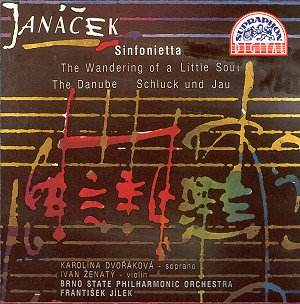It is a tribute to Janáček's
genius that we always think of him as a 20th century composer. In fact
he was aged 46 when the new century began, but of course he continued
to develop and the majority of his compositions of lasting value were
written in the final phase of his life.
Even so, the Indian Summer
that is Janáček's final decade contains far more music than the
great operas and instrumental works on which his reputation as
one of the century's greatest composers rests. This disc is worth hearing
for that reason alone, since all the music dates from 1924 or later,
yet only the Sinfonietta is at all well known.
Composed in 1926, the Sinfonietta uses a large orchestra,
the outer movements requiring a complement of extra brass, including
fourteen trumpets. While this Supraphon recording has the company's
preferred resonant acoustic, it is still most impressive, allowing the
magnificence of the sound to swell (Try TRACK 1: 1.10). This orchestra
is the authentic Janáček orchestra, since the composer spent most
of his creative life in the city, and Frantisek Jilek is a sympathetic
interpreter. Other performances (try Rafael Kubelik on DG) may
have more brilliance and bite, but Jilek always makes the right judgements.
It is not only the celebrated
outer movements of the Sinfonietta that contain remarkable music, the
whole of the work is remarkable. It is one of Janáček’s best compositions.
Distinctive and inspired, the potent motifs which from which the material
of each movement develops, are given just the right pacing and shaping
(Try TRACK 4: 0.00). In every way this is a valid and a committed performance,
though the listener will have to make a personal judgement about the
acoustic.
The short Danube Symphony plays for sixteen minutes,
and has never established a strong repertory position. It was inspired
by a visit to Bratislava in 1923 and composed the following year, although
never completed. The recent version is the work of Leos Faltus and Milos
Stedron, who were also responsible for the completion of the Violin
Concerto, while the incidental music Schluck und Jau was reconstructed
by Jarmil Burghauser.
The nature of the symphony is captured by the final
sentence of the insert note by Jana Smakalov: 'Although The Danube has
remained a torso, waiting for a final revision and montage, the material
it contains and its musical potential are such that it should not be
forgotten in the unfinished form.' The third movement introduces an
unexpected role for a coloratura soprano, and the music is particularly
striking (Try TRACK 8: 0.00).
Of these unknown works, it is the Violin Concerto,
The Wandering of a Little Soul, that has come closest to establishing
a regular position on the international concert platform. It was composed
in 1926 after Janáček's visit to London,
inspired by the playing of Adila Fachiri in the Violin Sonata. A single
twelve-minute movement, until its reconstruction in 1988 it was always
considered to be only a fragment, whereas it was practically complete.
Apparently the problem was caused by the composer's untidy working
methods, since several pages were found amid the manuscripts of the
later opera The House of the Dead, to which some of the music relates.
The performance is strong and distinctive, with Ivan Zenaty a committed
and able soloist (Try TRACK 10: 5.23).
The ten minutes of incidental music to Schluck and
Jau dates from Janáček's last year,
1928, when he was asked to contribute music for a play by Gerhart Hauptmann.
His death on 12th August frustrated the plan, and the music remained
unheard until the leading Czech musicologist Jarmil Burghauser reconstructed
it in 1978 from the sketches. While
this is in no sense a substantial achievement, it does rank as possibly
the last music Janáček composed, and as such is certainly worthy
of our attention (Try TRACK 11: 0.00). In this sense it is typical of
this enterprising and worthwhile disc.
Terry Barfoot
